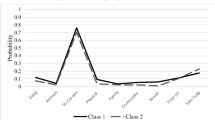Abstract
The association between child psychopathology and reversals in family hierarchies (where the child is seen as equal or higher in the hierarchy than the parental figures) were examined with the Madanes Family Hierarchy Test on a sample of 177 clinic-referred boys. Madanes' original findings of the association of substance use and deviant family hierarchy were replicated in this younger sample, (age 7 to 12). Boys diagnosed with Conduct Disorder reported significantly more deviant hierarchies while boys diagnosed with Overanxious Disorder reported significantly fewer deviant hierarchies. Follow-up results revealed some instability and lack of informant agreement, but the hierarchy measure was not confounded by age, race, SES, IQ, or parents' marital status.
Similar content being viewed by others
References
American Psychiatric Association, Committee on Nomenclature and Statistics (1987).Diagnostic and statistical manual of mental disorders. (rev., 3rd ed.). Washington, DC: American Psychiatric Association.
Costello, A. J., Edelbrock, C. S., Dulcan, M. K., Kalas, R., & Klaric, S. (1987).Diagnostic Interview Schedule for Children (DISC). Pittsburgh, PA: Western Psychiatric Institute and Clinic, School of Medicine, University of Pittsburgh.
Elliott, D. S., Huizinga, D., & Ageton, S. S. (1985).Explaining delinquency and drug use. Beverly Hills, CA: Sage Publications.
Haley, J. (1976).Problem-solving therapy. San Francisco, CA: Jossey-Bass.
Hollingshead, A. B. (1975).Four factor index of social status. New Haven, CT: Yale University.
Lahey, B. B., Loeber, R., Stouthamer-Loeber, M., Christ, M. A. G., Green, S. M., Russo, M. F., Frick, P. J., & Dulcan, M. (1990). Comparison of DSM-III and DSM-III-R diagnoses for prepubertal children: Changes in prevalence and validity.Journal of the American Academy of Child and Adolescent Psychiatry, 29 620–626.
Loeber, R., & Stouthamer-Loeber, M. (1986). Family factors as correlates and predictors of juvenile conduct problems and delinquency. In M. Tonry & N. Morris (Eds.),Crime and justice (Vol. 7, pp. 29–149). Chicago, IL: University of Chicago Press.
Madanes, C., Dukes, J., & Harbin, H. (1980). Family ties of heroin addicts.Archives of General Psychiatry, 37 889–894.
Madden, D. J., & Harbin, H. T. (1983). Family structures of assaultive adolescents.Journal of Marital and Family Therapy, 9 311–316.
Minuchin, S. (1974).Families and family therapy. Boston, MA: Harvard University Press.
Preli, R., & Protinsky, H. (1988). Aspects of family structures in alcoholic, recovered, and nonalcoholic families.Journal of Marital and Family Therapy, 14 311–314.
Protinsky, H., Keller, J., & Gilkey, J. (1989). Hierarchy reversals in clinical and nonclinical families.Family Therapy, 16 289–291.
Van Kammen, W. B., Loeber, R., & Stouthamer-Loeber, M. (1991). Substance use and its relationship to conduct problems and delinquency in young boys.Journal of Youth and Adolescence, 20 399–413.
Author information
Authors and Affiliations
Rights and permissions
About this article
Cite this article
Green, S.M., Loeber, R. & Lahey, B.B. Child psychopathology and deviant family hierarchies. J Child Fam Stud 1, 341–349 (1992). https://doi.org/10.1007/BF01321290
Issue Date:
DOI: https://doi.org/10.1007/BF01321290




